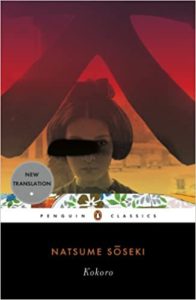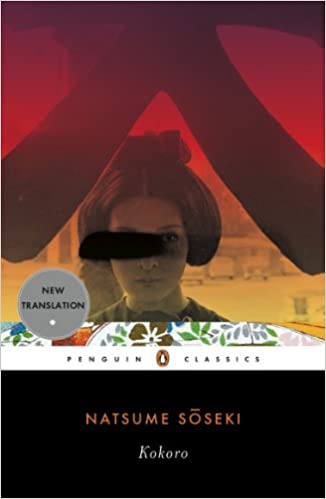Review by Tina deBellegarde
First published in 1914, Natsume Soseki’s timeless classic Kokoro has been graced with three translations. My first exposure to this book was through Edwin McClellan’s lovely 1957 version. For my re-introduction to Kokoro, I had the pleasure of reading Meredith McKinney’s 2010 translation.
Kokoro (which means heart) offers deep insight into the human psyche and investigates several internal struggles, especially the darker sides of admiration, envy and temptation. The story is set in the late Meiji (1868-1912) and early Taisho (1912-1926) eras and explores the evolving Japanese mores of the times, focusing on the contradictory impulses of honoring the common good versus individual needs and desires.
The book is broken into three parts. The narrator is an impressionable university student in Tokyo who latches on to an older man he chooses to call Sensei. Part One establishes their relationship. The student is mesmerized by Sensei’s enigmatic manner and admires the man despite proof that he is not a productive member of society. We also learn that Sensei has a sadness and cynicism that haunts him.
In the short middle section, the narrator returns home to nurse his dying father. We witness how the narrator compares these two important men in his life and how they measure up in his esteem by their social standing, education and character.
Section three is a long letter from Sensei to the narrator where he finally confides his painful history, a secret he has shared with no one. He is a jaded man, and over his lifetime he has learned not to trust anyone, including himself. He hopes his confession to be a form of redemption for he intends his story to be a moral lesson to the narrator and perhaps to others.
Kokoro is remarkable in its ability create a sense of crescendo with very little action. The stakes build slowly, and as readers we can feel the steady movement toward an inevitable conclusion. On the other hand, the narrator’s youthful optimism blinds him to the negative outcomes the readers take for granted.
Soseki provides a wonderful canvas for a translator by offering a straightforward plot and simple structure, but they are deceptive. The challenge for the translator is to showcase the existential questions addressed in the book. McKinney does this well by providing us with a modern translation that does not obscure the feel of the era.
She has broken up the book into very brief chapters and short paragraphs. Where Edwin McClellan’s translation is one long story broken up into many scenes, McKinney has chosen to use these scene breaks as chapter breaks, making the already accessible narrative even more readable and digestible. These chapter breaks allow the reader to pause and consider the moral questions posed throughout the book.
McKinney’s language is more colloquial than McClellan’s which serves the narrative well, since so much is revealed through dialogue. For example, she eschews the formal third-person expression “one.” In addition, she chooses simpler punctuation. Periods replace colons and semi-colons. Overall, a very pleasant read.
If you have never read Kokoro, this translation is a wonderful first experience. If you are not new to the book, you will find that McKinney has made revisiting this story a delight.


